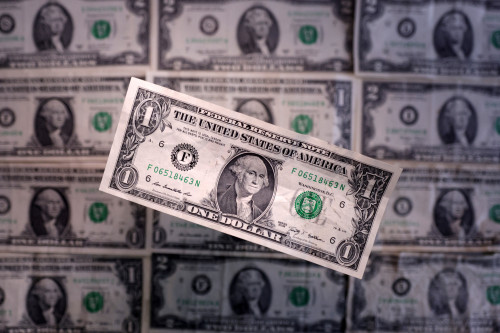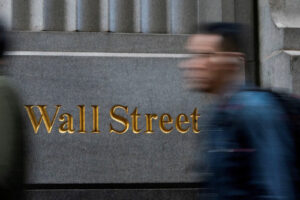By Rae Wee
SINGAPORE (Reuters) – In just a week, the dollar has gone from a safe haven to investors’ whipping boy as U.S. President Donald Trump’s chaotic tariffs on friend and foe alike undermine decades of trust in the world’s reserve currency.
The sudden loss of confidence was nowhere more stark than in the Treasury market, which saw the largest weekly increase in borrowing costs since 1982 as offshore funds fled.
“The U.S., almost overnight, it seems to have lost its safe-haven attributes,” said Ray Attrill, head of FX strategy at National Australia Bank.
“There is … a loss of confidence to some extent … you’re overlaying that with the loss of exceptionalism and the view that in the short-term, at least, it’s the U.S. economy that’s going to be suffering more than any other from what’s happening on the tariff front.”
The dollar, already on course for its worst year since 2017, on Friday plunged to a decade-low against the Swiss franc and dropped to its weakest level against the euro in more than three years.
“The whole premise of the dollar as a reserve currency is being challenged, effectively, by what we’ve seen since Trump’s election,” said Attrill.
It was the establishment of the Bretton Woods system in 1944 that cemented the greenback’s global standing. Post-war planners devised a system built on exchange rate stability and deepening international trade and the dollar remained dominant even after Bretton Woods broke down in the early 1970s.
But Trump’s recent moves on trade have shaken perceptions. In a matter of days he has imposed hefty tariffs on the world, made an abrupt U-turn on his decision and intensified a trade war with China, throwing into question the reliability of the U.S. administration.
Stocks globally have shed trillions of dollars and world markets have gone into a tailspin.
“Regardless of how the next 90 days evolve, the U.S.’s international reputation has been eroded,” ANZ group chief economist Richard Yetsenga said in a note.
“The global economy is in a weaker position than it was before the tariffs.”
Martin Whetton, head of financial markets strategy at Westpac, said this week’s massive shift in U.S. dollar swap spreads, the “sharp flash-crash” move higher in U.S. Treasury yields and the heavy selloff in the dollar showed “a stripping away of the shield of liquidity and safety”.
“By losing or diminishing credibility as a financial safe haven, the willingness of creditors to lend money to the U.S. is reduced,” he said.
Things are so bad that the U.S. now has to pay investors more to borrow their money than Italy, Spain or Greece.
To be sure, some believe the dollar selloff could be temporary.
“Once the uncertainty is more or less gone, the tariff rates are set, there’s no back and forth, we’ll see the dollar getting stronger again because the eventuality is that the tariffs are set in place and this is the new normal,” said Francis Tan, chief strategist for Asia at Indosuez Wealth Management.
But even if it does prove short-lived, any erosion of the dollar’s standing as a safe-haven is bad news for investors.
For those who have piled trillions of dollars into buoyant U.S. markets in recent decades, a sharp dollar fall could result in higher interest rates for longer as price pressures at home persist, which is bad for bonds and equities.
Foreigners owned $33 trillion of U.S. debt and stocks at the end of 2024.
“The Trump administration’s ambitious agenda to reform the international financial system seems almost oblivious to the reality of America’s extreme dependence on foreign capital as reflected in its net international investment position,” said Chris Wood, global head of equity strategy at Jefferies, in a note.
(Reporting by Rae Wee in Singapore and Kevin Buckland in Tokyo; Additional reporting by Wayne Cole in Sydney; Editing by Kate Mayberry)



